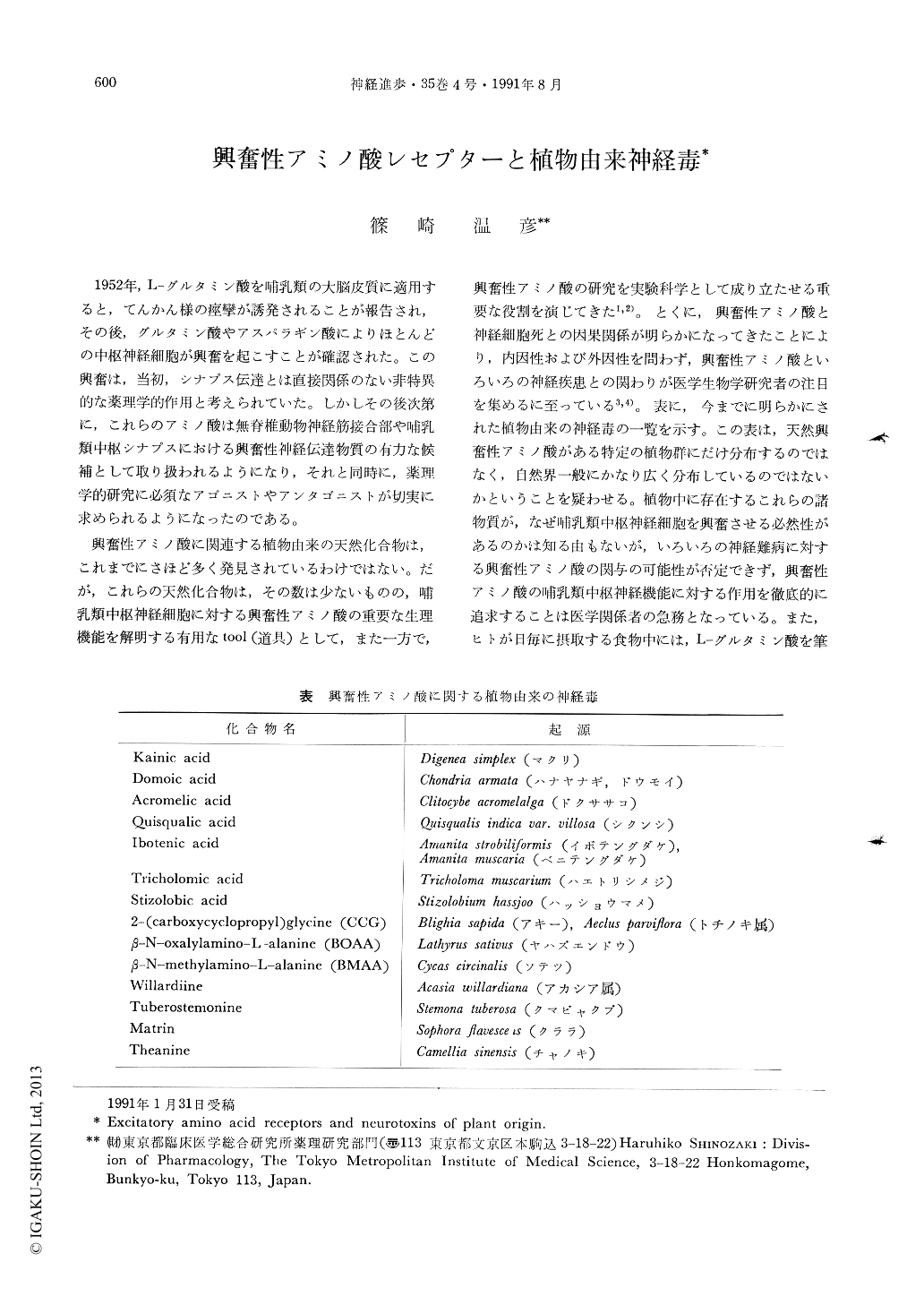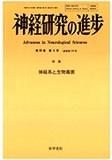Japanese
English
- 有料閲覧
- Abstract 文献概要
- 1ページ目 Look Inside
1952年,L-グルタミン酸を哺乳類の大脳皮質に適用すると,てんかん様の痙攣が誘発されることが報告され,その後,グルタミン酸やアスパラギン酸によりほとんどの中枢神経細胞が興奮を起こすことが確認された。この興奮は,当初,シナプス伝達とは直接関係のない非特異的な薬理学的作用と考えられていた。しかしその後次第に,これらのアミノ酸は無脊椎動物神経筋接合部や哺乳類中枢シナプスにおける興奮性神経伝達物質の有力な候補として取り扱われるようになり,それと同時に,薬理学的研究に必須なアゴニストやアンタゴニストが切実に求められるようになったのである。
興奮性アミノ酸に関連する植物由来の天然化合物は,これまでにさほど多く発見されているわけではない。だが,これらの天然化合物は,その数は少ないものの,哺乳類中枢神経細胞に対する興奮性アミノ酸の重要な生理機能を解明する有用なtool(道具)として,また一方で,興奮性アミノ酸の研究を実験科学として成り立たせる重要な役割を演じてきた1,2)。とくに,興奮性アミノ酸と神経細胞死との因果関係が明らかになってきたことにより,内因性および外因性を問わず,興奮性アミノ酸といろいろの神経疾患との関わりが医学生物学研究者の注目を集めるに至っている3,4)。
Excitotoxins isolated from various plants have had a marked influence upon the development of neuroscientific research on excitatory amino acids. In this chapter neuropharmacological and neurological actions of several compounds of plant origin, including kainic acid, domoic acid, acromelic acid, quisqualic acid, ibotenic acid, stizolobic acid, 2-(carboxycyclopropyl) glycine, β-N-methylamino-L-alanine, β-N-oxalylamino-L-alanine, willardiine, tuberostemonine, matrine and theanine, were described. Powerful excitatory actions of kainic acid on the mammalian central neurons gave rise to the excitotoxic concept that glutamate destroys neurons by excessive activation of excitatory receptors on the dendrosomal surfaces of neurons. Systemic administration of kainic acid or domoic acid to the rat causes characteristic behaviour and selective neuron damage, in particular, in the CA1 region of the hippocampus. The CA1 damage produced by systemic kainate closely resembles that produced by cerebral ischemia. Domoic acid causes a potent depolarization of mammalian central neuron and selective neuron damage in a manner quite similar to kainic acid. A new kainoid, acromelic acid, has been isolated from a poisonous mushroom. Acromelic acid demonstrates the most potent depolarizing activity among known excitatory amino acids, but there is no apparent electrophysiological difference in qualitative features of the depolarization induced by three kainoids, except for the time course of their depolarizing responses. It seems reasonable to predict that acromelic acid would demonstrate excitotoxic actions quite similar to kainic acid or domoic acid, however, systemic administration of acromelic acid exhibits abnormal behaviour quite distinct from that of kainic acid or domoic acid. The most pronouced behavioural changes seen after the single systemic administation of acromelic acid are the extension, transient flaccid paralysis of the hindlimbs and the following severe spastic paraplegia, which are quite distinct from those induced by systemic administration of kainic acid or domoic acid. The distribution of neuron damage induced by systemic administration of acromelic acid is confined to the lower spinal cord in the rat, in particular, to the lumbar and sacral segments, as predicted from behaviour signs, and closely resembles that produced by spinal ischemia. There was regional difference in the expression of c-fos mRNA induced by kainate and acromelate. Kainic acid induced c-fos mRNA in a variety of brain areas including the CA1, CA3 and CA4 pyramidal cells of the hippocampus, lateral septum, hypothalamic nucleus, amygdala complex, entorhinal cortex, and pyriform cortex, while acromelic acid significantly induced c-fos mRNA only in the granule cells of the dentate gyrus, lateral septum and hypothalamic nucleus.

Copyright © 1991, Igaku-Shoin Ltd. All rights reserved.


